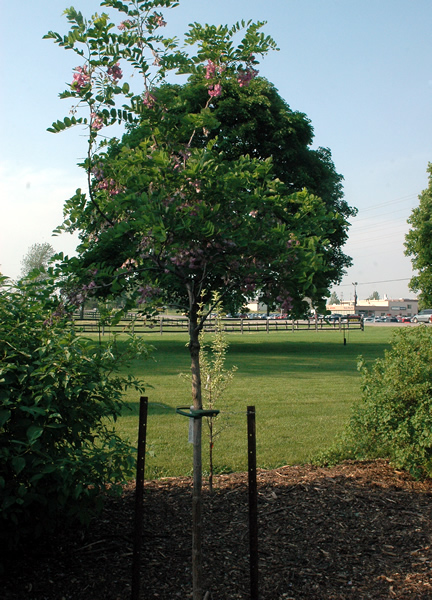
Woody > Robinia > Robinia hispida > Robinia hispida
Robinia hispida
Bristly Locust
Origin: Southeastern United States.
Mike's
Opinion


"
A very nice looking plant overall. It’s beautifully coloured flowers are aesthetically pleasing during late spring to autumn, while its bristly stems add winter interest to the garden. The plant is very weak-wooded so it would not be able to handle any strong winds, which greatly reduces the area where it can be planted. Although it does not produce as much fruit as R. psuedoacacia it still grows with ease from seed. It is slightly invasive which may be of concern in some areas.
Michael Pascoe, NDP., ODH., CLT., MSc. (Plant Conservation)
"
| Family |
| Fabaceae |
| Genus |
| Robinia |
| Species |
| hispida |
| Category |
| Woody |
| Type |
| Tree (deciduous), Shrub (deciduous) |
| Pronunciation |
| USDA Hardiness Zone |
| 5 - 9 |
| Canadian Hardiness Zone |
| 6a |
| Temperature (°C) |
| 23 |
| Temperature (°F) |
| -20 - 30 |
| Height |
| 3 m |
| Spread |
| 3 m |
Photographs
Description and Growing Information
Flowering Period
| General Description |
| Multi-stemmed, can be trained into a small tree. Stems and fruit covered in long hairs, flowers in late spring. |
| Landscape |
| When the leaves are dropped in late autumn the reddish-golden spines along the stems become quite evident. It has beautiful pink flower racemes which bloom in late spring. It can also be used to stabilize sandy banks and impoverished, dry, sterile soils since it is quite tolerant of lean, disturbed soils. |
| Cultivation |
| Prefers dry, sandy soils and full sun. It has very weak wood so it would be best planted out of windy situations. |
| Shape |
| Typically a round, wide-spreading shrub, but can be trained into a small tree with a loose, oval form when grafted onto R. pseudoacacia. Normally though it is quite scrubby in character. |
| Growth |
| Fast |
| ID Characteristic |
| Long, bristly hairs on stems and pods. Beautiful racemes of pink flowers. |
| Pests |
| Silver-spotted Skipper. Nothing too severe. |
| Habitat |
| Found from southeastern United States to the more southern parts of Ontario and Nova Scotia. Usually found in dry, sandy soils. |
| Bark/Stem Description |
| Young shoots covered in slightly bristly hairs that are brownish-red in colour, with the hairs growing in length as the plant ages. The hairs on older stems of the plant are much less dense. Paired thorns can also be found along the nodes. |
| Flower/Leaf Bud Description |
| The leaf bud is incredibly small and is hidden beneath the base of the petiole. It is amber-gold in colour. Both the terminal and lateral buds are very small as well, but they are a light gray-white colour and are slightly tomentose. |
| Leaf Description |
| Rich green coloured foliage, leaves are approximately 15 cm long, pinnately compound with 9 - 15 ovate leaflets that are approximately 3.5 cm long, which also are slightly pubescent along their underside. |
| Flower Description |
| Beautiful deep rose coloured flowers produced in pendulous racemes of 5 - 10 florettes. |
| Fruit Description |
| Brown pod covered with long hairs just like the stems. After opening, the pod twists and is retained on the plant for a period of time. |
| Colour Description |
| Rich green foliage with beautiful deep rose coloured flowers from mid to late spring. |
| Texture Description |
| Slightly rough and bristly throughout stems and fruit. Slightly pubescent underside to the leaflets. |
| Notable Specimens |
| Pinafore Park, St. Thomas, Ontario, Canada. |
| Propagation |
| Produces a small amount of fruit but will easily grow from seed. In late summer the fruit ripens and are dispersed. They germinate quite readily the following spring. 5 – 10 cm long root cuttings can be taken in mid-spring. It can also be grafted onto the understock of R. pseudoacacia in the early spring. |
